feature image via Shutterstock
Welcome to Be The Change, a series on grassroots activism, community organizing, and the fundamentals of fighting for justice. Primarily instructional and sometimes theoretical, this series creates space to share tips, learn skills, and discuss “walking the walk” as intersectional queer feminists.
“KaeLyn does everything fast.”
That’s what my mom used to say about me. It’s true. I love the feeling of going fast, of accelerating, of gaining momentum, whether that’s on a roller coaster or marching in the street or winning a legal victory. I can’t stand still. I’m always thinking about what’s coming next and what happens after that and after that and after that.
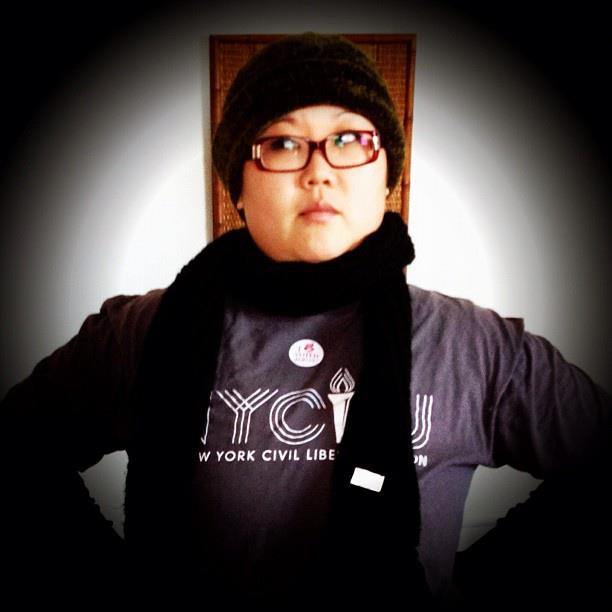
So the first thing you need to know about me as a community organizer is that my mind is a vortex of competing thoughts and distracting big ideas and fragmented mental to-do lists. I am no Rachel. I’m not even a little bit Type A. And that’s OK. I’ve found many effective political and activist leaders aren’t naturally obsessed with order. (If they’re lucky, they can surround themselves with people who are good at those things.) Ironically, “organized” isn’t the only core component of organizing. Flexibility and emotional intelligence and the ability to roll with the punches are valuable skills, too.
That doesn’t mean that chaos is the best path to social and political change. Or that Type A folks aren’t also great organizers. In fact, as an organizer, you have to streamline your thinking. You have to think in terms of strategy when you’re building a campaign. Strategic thinking isn’t incongruent with creativity. Quite the opposite! I love a good strategy session!
A good campaign is a blueprint for success. It’s a visual guide to the big picture. It helps keep focus on the right goals and targets. It helps measure wins in a field where there are an awful lot of losses (and where you’re often up against opposition with deep pockets). It’s also a working document. It can expand to accommodate new ideas. It can help focus and frame campaign decisions as they arise.
There are many methodologies for sketching out a campaign plan. I personally use a modified version of the Midwest Academy plan. However, I’m not married to this model and there are plenty of others.
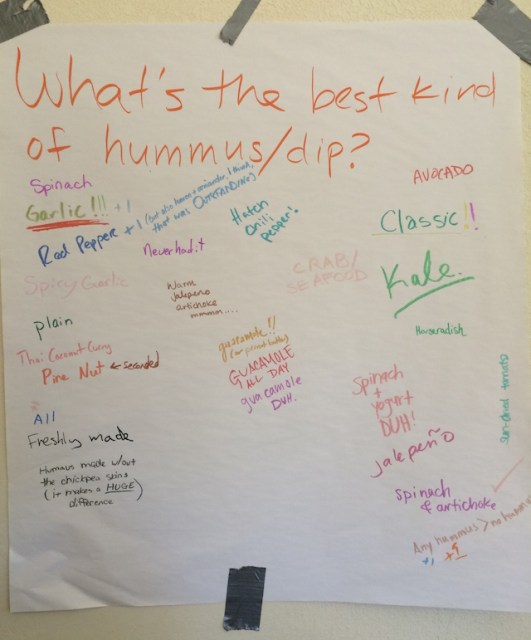
You certainly don’t need to pay to go to a training to become an organizer or execute a campaign plan (though if you can, go for it). Pretty much all campaign plans have similar key components:
Vision and Goals
The number one misstep folks make when organizing a campaign is starting with tactics before considering the goals, starting with the “what are we gonna do” before the “why are we doing this” and “what do we hope to accomplish.” Or confusing goals with a general vision. This isn’t always a bad thing. Revolutions can be seeded by spontaneous and reactionary activism. However, when talking about long-term change, you’re more likely to succeed if you are clear about the “what” and “why” before you jump into the “how.” In other words, don’t start from, “I want to have a rally.” Start from, “Here is what I feel outraged about and here is what I hope to accomplish.” Having a rally may be a tactic to do so (or not).
Vision
Your vision is the reason you are doing the work, the big big big big picture, the context for why your goals are important. Your goals should be in the service of your vision, but shouldn’t be your vision. For example, your vision might be: “End all men.” I’m sorry. Whoops. I meant, “A world without misogyny.” That’s a clear and aspirational vision, a good vision. But that statement would be a very vague and unhelpful campaign goal because it’s not tangible. It’s not measurable. A vision gives you something to aspire to and also something to remind you why you are doing the work. Often, the vision of our work is a world where our work isn’t even needed anymore.
Main Goal
A campaign has a primary goal and many smaller goals. You have one big picture goal. It can be something like passing a bill or policy, getting a governing body to take action, raising awareness about an issue or cause, getting a person elected, etc.
For example, it might be to get gender-neutral restrooms built on your campus or to spark a community dialogue about rape culture or to pass a state budget that includes funding for sexual health services or to promote kale hummus awareness, whatever. This is the end-goal for your campaign. If you’re 100% successful, this is the goal you will achieve.
Short-term and Medium-term Goals
Your short-term and medium-term goals are the little milestones along the way, the goals that will get you to your big goal, ultimately. These goals will correlate directly to your tactics. A goal might be to educate the public or to put pressure on a legislator or to inspire public discourse or to get media attention for your issue.
Goals and tactics ideally align. So, like, if your goal is to get media attention for your issue, you don’t want to have a private house party. That makes no sense. If your goal is to put pressure on the federal government, you don’t want to hold your rally at city hall. (Unless, of course, you live in a small town and city hall is the best place to get public and media visibility for your issue, in which case it might make sense.) Obviously, city officials are the wrong targets for getting a federal issue addressed and vice versa. Speaking of…
Targets
Your targets are the people who have the power to give you what you want. Check what I wrote there. People. People. Targets are people. Your target can’t be an institution or a place. Your target can’t just be “Congress” or “McDonalds” or “the administration.” You’ve got to dig deeper. “The White House” can’t give you anything, but the President might be able to. “Congress” can’t be your target, but Congressional members can. “The college” can’t be your target, but the President or Dean of your college can. “McDonalds” can’t be your target, but the owner of your local franchise or of the corporation can be.
Targets are the decision-makers who have the power to make your campaign goal reality. You may have more than one primary target. You may also have secondary targets, people who have the power to be influencers, even if they don’t have decision-making power. You may have different targets for different goals, though you will probably have consistent targets for the campaign as a whole.
Targets matter. If you are calling for a change to the electoral college, you don’t bring that to your state’s governor. The governor has no control over issues of national conflict. Unless your campaign plan involves garnering public, vocal support from lots of influential governors to put pressure on the federal government, in which case the governor may be a secondary target. You dig?
Allies & Opposition
Who will align with you? Who are potential supporters or coalition partners or event co-sponsors? What other people and organizations might be helpful to your campaign? Who is already doing similar work? Make a list of all your allies, as well as potential allies.
On the flip, who is your current opposition? What people and groups are actively working against you? Who do you think will be hostile to your campaign? Who is already doing work opposing your goals? Make a list of opponents and potential opponents. Hang it on the wall and throw darts at it. Hex it. Also take it into consideration when crafting your plan.
How is this helpful? Let’s say you want to have a rally. Are there groups or individuals who might be allies and would be willing to co-sponsor or speak or bring people with them?
On the flip, what is your opposition like and what might their tactics be? For example, when I worked at Planned Parenthood, we almost always got permits for our public demonstrations or at least notified the police, because there were almost always anti-abortion counter protesters. And having a permit allowed us to ensure we could keep the counter protestors at a safe distance.
Resources
What tools and information do you have access to that will help you achieve your campaign? This can be literal things like office supplies, a computer, a camera. It can be your volunteers or your staff. It can be your email list or access to different email lists. It can be a social media presence. It can be actual dollars and cents. Write down the tangible and intangible things you have in your back pocket to get the work done. This helps you see all that you have. It also helps identify where they may be gaps in resources that you will either have to fill or compensate for. Lack of funding is often, you know, a big resource challenge.
Tactics
This is the “what are we gonna do” section and the place where, taking everything you have mapped out into consideration, you decide what you are going to do, based on where you can have the most influence. How do you use your power to reach your targets to achieve your goals? Who is going to do these things and by when? This can include lots of things from earned or placed media strategies, to visibility actions, to petitions and letter-writing campaigns, voter registration, education, meetings with elected officials and influencers, coalition-building work, networking, door-knocking, social media outreach, digital strategy, street theatre, guerrilla organizing tactics, and lots and lots of other things.
The reason people start with tactics is because we want to do something when we see and experience injustice. We want to change things. We want to help. Sometimes this is the best way to do the work — it has to be reactionary and it has to been immediate. Almost always, though, some strategic thinking behind your tactics is helpful to long-term success.
The other reason people jump to tactics is that this is what we think of when we think of organizing. We think of rallies and protests and petitions and marching on the capitol. But what an organizer’s life actually looks like is only 10% (maybe less) those things. The majority of our time is building relationships and building power, making phone calls, answering emails, setting up meetings, going to meetings, sending out minutes, following up on tasks, dealing with coalition drama, and lots of things that aren’t very sexy or photo-worthy. And conference calls. Oh, so many conference calls. But that’s what it takes to build a winnable campaign. And it feels so good when you actually have a victory. It makes it all worth it.
Other Tools and Exercises
S.W.O.T. Analysis
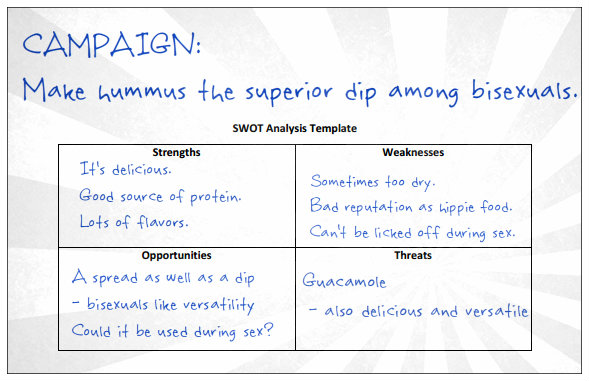
S.W.O.T. stands for Strengths, Weaknesses, Opportunities, and Threats. This is an exercise to help you build a picture of your current landscape. It can be really useful as part of a campaign plan or as the first step towards a campaign plan because it helps you start thinking both logically and creatively about the issue or person you’re campaigning for. What are the strengths of your group/issue/person/campaign? What are the potential weaknesses, a.k.a. areas that are possibly vulnerabilities? What opportunities exist, both ones that are easily reachable and those that are outside of the box? How about threats? A S.W.O.T. analysis is a brainstorming exercise and works especially well if you have more than one person working on the same campaign to generate conversation and new ideas.
For example, let’s say you’re working on a campaign to get more gender-neutral restrooms on your college campus. OK, so here’s what the S.W.O.T. might look like (truncated; obviously this would probably be a longer list).
Strengths: good personal relationship with the Dean of Students, campus has good track record on supporting LGBTQ students, a few single-stall bathrooms currently available, politically active and vocal genderqueer and gender non-binary population living on campus, student body is fairly progressive and would likely support
Weaknesses: no current funding for upgrading or building new multi-stall bathrooms, many students prefer using gendered restrooms, could unintentionally alienate trans students who prefer using the restroom that corresponds to their gender (must also ensure all people can use the restroom they feel most comfortable using), residence halls are currently gender segregated by floor, many people don’t understand non-binary gender identity or why gendered restrooms often aren’t safe for gender non-conforming people
Opportunities: potential to work with disability rights student group to push for more restrooms that are both gender-neutral and fully accessible, could possibly work with queer alumni to raise funds for restroom upgrades, the college is currently raising funds for a capital campaign to build a new science building which could potentially include single stall restrooms
Threats: school administrators don’t want to spend money on bathroom upgrades, argument that small number of current single-stall bathrooms is sufficient, don’t want to fuel the fire of conservative extremists who already focus on bathrooms to deny trans people rights, current director of resident life is very politically conservative
Power & Relationship Mapping
This is a visual exercise to really drill down to how to influence your target(s). In the center of this map, there is your target, the person who has the power to give you the thing you want. Then you look at who has the power to influence them, who is in their world. Then you look farther out at who has the power to influence the influencers or how you can reach the influencers. Here’s a few versions of this kind of tool.
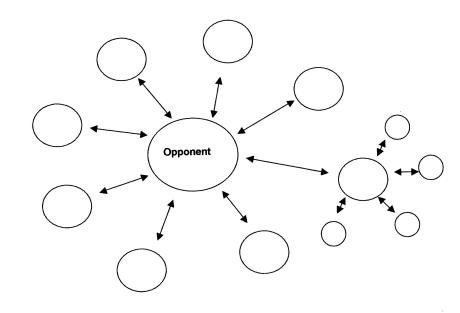

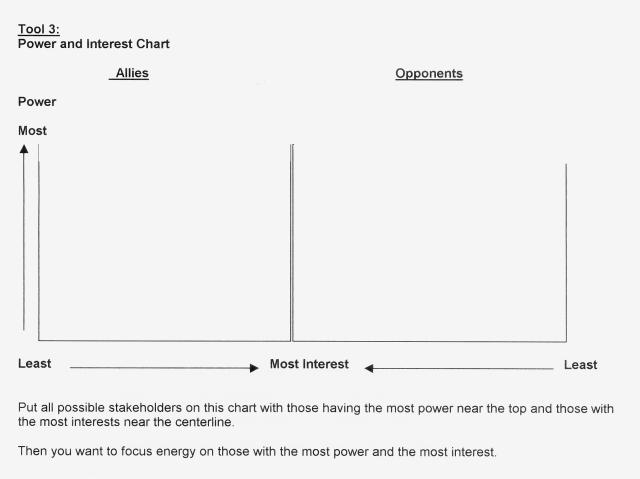
An Exercise in Power
I presented a workshop at a Girls Rock Camp once on activism and organizing. It was a bit of a challenge for me, even as an experienced facilitator and trainer, distilling my organizing knowledge into bites that were palatable and interesting to a diverse group of 8-14 year old girls. I consulted my mom, a retired first grade teacher who’s excellent with kids. I thought about what they needed to know to understand why activism is important and, most importantly, how to tap into their own power in a world that says girls don’t have any power.
Here’s the exercise I came up with to open the workshop. I printed out pictures of different people, all different ages, ethnicities, genders, walks of life. Babies. Elders. Kids. White men in suits. Black women in suits. White men in dirty clothes. Women in construction gear. Models. Girls with braces and braids. I printed out about 25 pictures. I gave them to the girls in random order and asked them to put the pictures in a row by who they thought had the most power. I didn’t give any additional instructions.
At the end of the exercise, we discussed where they put the people and how they decided who had power. Because kids know a lot more than we think they do, you can imagine who was at the bottom. It was the Black baby, with the white baby next to that. At the top was the middle-age white man in the suit.

We talked about race and class and gender and ageism. Or, rather, they described to me why they thought men had more power than women, why white men looked more “professional” than Black men, why kids have less power than adults, why relationships determine power. One of the younger girls excitedly raised her hand as we were discussing this and said, “I put the baby there [at the end] because it’s little. Babies can’t do nothing by themselves so they don’t have power. BUT if the baby cries, the grown-up’s got to pick it up. So the baby has power over the grown ups, too.”
Damn, kids are smart. Girls are smart. And that’s how we talked about power, about how those at the top have the most institutional power. But when those who have the least power make enough noise, the ones at the top have to listen.
That’s what campaign planning is all about. It’s about harnessing the power of the grassroots, tapping into the power of those with influence, and forcing the hand of those at the top, who have the power to make the changes we demand.
I don’t know if it’s that queers have more empathy or more drive to fight injustice or if we just really like community processing and free pizza, but I seem to meet queer organizers everywhere, in every place, working on every issue. We are an activist community.
Let’s use this series to keep talking to each other. And let’s talk as a community about organizing for our collective liberation. So tell me about your campaign tips and tricks and your victories and challenges. Or ask questions. I have a feeling there’s a wealth of knowledge right here in the Straddleverse and we need to organize now, more than ever.







